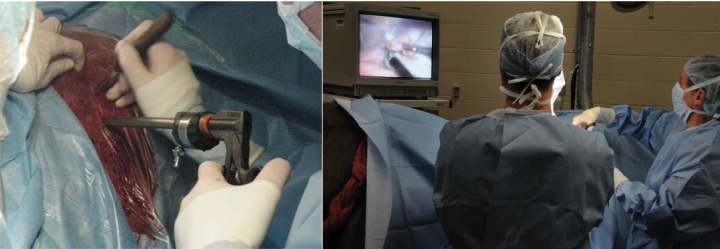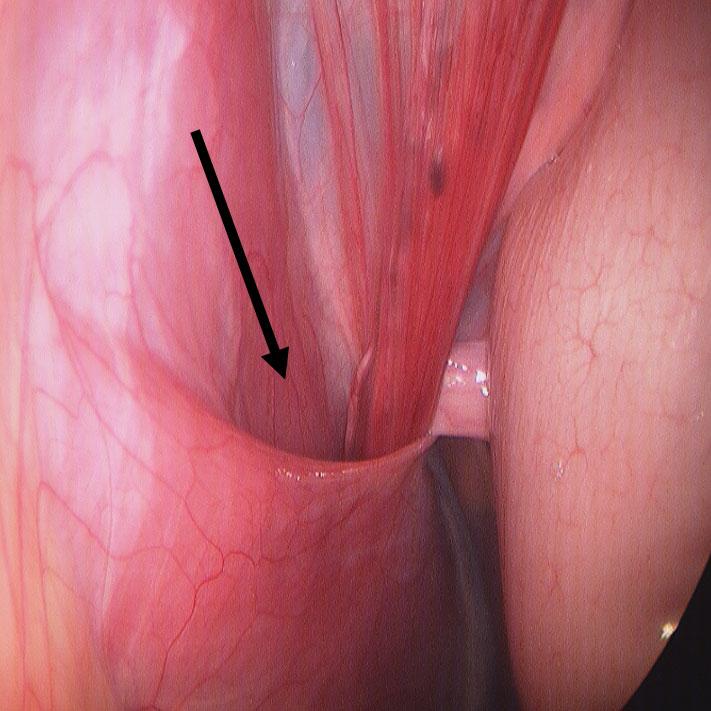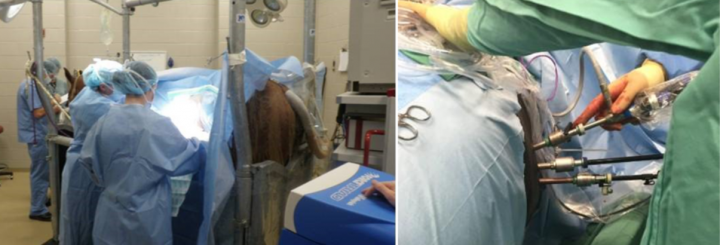Laparoscopy
Endoscopic surgery of the abdomen and thorax can be very useful in horses for a variety of different problems. It allows visualisation and treatment of parts of the abdomen (laparoscopy) and thorax (thoracoscopy) which can be difficult to reach using other forms of surgery and has the significant advantages of being able to be performed with the horse standing and with minimal incisions.
The technique
A long narrow camera and instruments are inserted into the abdomen (laparoscopy) or thorax (thoracoscopy), through 2-3 small (approximately 1.5cm long) keyhole incisions in the flanks or between the ribs. For removal of structures such as ovaries and testicles, a specialist device (Ligasure®), which seals the blood vessel and ensures the a viable seal before cutting is commonly used. A huge advantage of these techniques compared to conventional surgery is the decreased pain associated with surgery through the avoidance of large incisions, this allows for a smoother recovery. Additionally, because of a horses size, it is possible to visualise areas that cannot otherwise be seen and perform controlled surgery in those areas. It can be performed in either the standing or anesthetised horse. Notably laparoscopy cannot be used for all surgeries, such as colic surgery, when larger manipulations of intestines need to be performed.
Common procedures
- Ovariectomy - removal of one or both ovaries.
- Cryptorchidectomy - removal of retained testicles
- Inguinal ring closure - for horses who are prone to herniation
- Nephrosplenic space ablation - after a colic caused by nephrosplenic entrapment
- Pleural lavage – for cases with pleuropneumonia
There are many other uses of laparoscopy both singly or in combination with conventional surgery that can be used to improve our ability to treat disorders of the gastrointestinal and urogenital tracts.

The small incisions reduce pain after surgery and speed return to normal function. The rehabilitation time will vary depending on the type of surgery but commonly would require one month total before returning to full work (2 weeks box rest with light walking, 2 weeks small paddock turnout then return to normal).
Ovaries can be removed if they cause behaviour problems or only one ovary can be removed if it has become a tumour (as above). The prognosis after removal of one or both ovaries is excellent. If only one is removed the mare may continue to have foals in the future. Uterine problems can also be address using a combination of laparoscopy and traditional surgery.
Some horses (rigs / cryptorchids) have testicles that do not descend into the scrotum as normal and have to be removed from the abdomen to fully castrate the horse. Laparoscopy enables this to be performed quickly and with minimal invasiveness.

Inguinal ring closure is closure of the internal inguinal ring (indicated by the arrow in the picture looking from the inside of the abdomen), which is the gap in the body wall where the testicles move down from the abdomen into the scrotum during normal development of the neonatal foal This gap remains for life and usually does not cause any problems. However in some young foals and occasionally older stallions, intestines get stuck going down that gap and out into the scrotum. The gap can be closed using laparoscopy to prevent this from happening on a repeated basis. The surgery is often performed under standing sedation but may be performed under general anaesthesia if necessary.
Thoracoscopy is sometimes recommended in cases with severe pleuropneumonia, as it allows visualisation of the pleural cavity, directed lavage and debridement if required. Thoracoscopy can also be used to obtain lung biopsies in selected cases.
These are some examples of surgeries that are best performed with laparoscopy. There are other examples and if you have any questions please feel free to contact the equine hospital. Laparoscopy is currently being offered by two surgeons with extensive experience in this area - Richard Reardon and Yvonne Elce.


